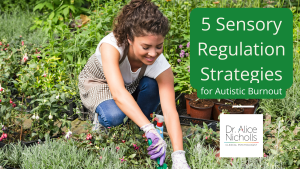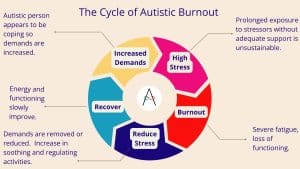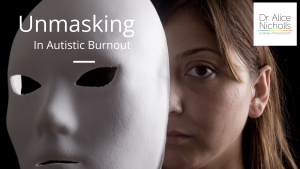Do you know someone who is struggling with autistic burnout?
Are you their partner, close relative or friend?
Do you want to help?
Maybe you are in autistic burnout and you want some support but you don’t know how to ask?
This article will cover what other people can do to help a person in Autistic Burnout.
For more information on how to get out of Autistic Burnout please see my previous article.
1. Don’t Add to the Overwhelm
If someone is in autistic burnout, or on the edge of it, they will struggle with any additional demands. Even asking them to explain what is going on or asking them what they need can be too demanding.
They may not know the answer, they may not have the energy for the social interaction required and they may not be sure if it is okay to ask for what they need. These thought processes are likely to be too difficult if they are already feeling too overwhelmed.
Of course some autistic people might want to talk and might use the opportunity to process what is going on for them. So don’t assume they don’t want to talk either. You could ask ‘would you like to talk about what is bothering you?’. This provides an opportunity for them to talk if they want it but is also easy to answer with a simple ‘no’ if they are feeling too overwhelmed.
Avoid unnecessary small talk or questions, before you ask any question, ask yourself, is it important? and can I get this information elsewhere?
Try not to make any changes to plans or normal routines, even if they seem small to you. It will help the autistic person if everything remains as predictable and reliable as possible. This could be down to eating the meals you usually eat together, watching the same shows or playing the same games together.
Ask closed questions, this advice is contrary to almost all therapeutic training ever. But answering a closed question with a ‘yes/no’ answer is much less taxing than having to think up a lengthy response. So consider asking ‘do you want a cheese sandwich’ rather than ‘what do you want for lunch’ . Use the information you already have about the person to guide the questions you are asking. For example, if you know they have a cheese sandwich most days at 12pm, then ‘do you want a cheese sandwich?’ is a sensible question to ask at 11:55am. If you know they always make a request of you at a certain time of day then you might not need to communicate about it at all. Cut down on unnecessary and stressful interactions.
Some autistic people find it easier to have text conversations, if this is the case then sending them a text message asking them simple questions can be helpful. You could even ask them via text if they want to talk or if they would like you to give them some space.
2. Try Not to Escalate the Situation
I know this is easier said than done. If the person you are worried about snaps at you, shouts at you or is just rude or abrupt with you it can leave you feeling triggered. You may feel that you are being treated unfairly, that you were just trying to help and that they should feel bad for how you are feeling. While you absolutely don’t deserve to be treated badly and need to protect your self and your own mental health, please bear in mind that a person in Autistic Burnout is not choosing to behave in this way. Likely they are trying their absolute best. It is likely that burnout is limiting their ability to communicate in a calm and measured way. Try not to criticise or snap back, hard as it is, this is likely to just escalate the situation further.
Take some time away from each other and do something that helps you to calm down. If you need to talk to someone else then do, or consider engaging in a hobby or going for a walk. Try to do something that will help you to calm down and get some perspective on the situation.
3. Develop an Easy Way of Communicating Stress
When we find it difficult to communicate how we are feeling and we are feeling stressed it can feel impossible to let other people know. It can help to develop a non-verbal way of communicating how stressed the person is.
Wait until they are ready to discuss a system and then between you, decide on a shared language for talking about stress at a time of high stress.
Some people use a traffic light system where green is okay, orange is in the warning zone and red is absolute overwhelm. Other people might rate their stress on a 5 point or 10 point scale where 0 is the least stressed they’ve ever been and 5 or 10 is the most stressed they’ve ever been. You could make up your own code based on a shared interest, TV programme or video game. You could agree that when you ask how stressed they are they will give you a rating, or you might agree that you will only communicate this via text.
You might find other ways of signaling stress levels to each other, for example by wearing noise canceling headphones or having a sign on the fridge/office/bedroom door. It might be that the person is already trying to send you a signal (e.g. by shutting themselves in the bedroom or shutting the office door) but that you are not aware of this. In such a case it is helpful to have a clear rule. E.g. if the door is closed I will not come in or I will wait 30 minutes and then text you.
4. Develop Reactive Strategies
When you are both relatively calm, and the autistic person is rating their stress level as relatively low. Work together to discuss what they need when they are in a high stress state. They may already know what they want at this time and they may not. Some people want to be left alone, others benefit from deep pressure like a strong hug or from other caring behavior such as making a cup of tea. It might help to develop a short list of activities you can offer or they can ask for when the person appears stressed so that there is less need for decision making.
5. Identify the Causes of Burnout
I’ve written a detailed list of what causes autistic burnout in a previous article. Basically, we know that autistic burnout is caused by too much stress and not enough resources. The autistic person in your life may well know exactly what is causing their burnout, they may know some of what is causing it or they may be really unsure if everything feels stressful.
At a time when they are rating their stress levels relatively low and are happy to talk or communicate via text/email you can ask them what contributes to their stress levels. If they aren’t entirely sure then you might have also noticed some triggers and discussing these might help them to identify sources of stress. Come up with a list of stressors. If you are stuck for ideas then please see my previous article You may find that it helps to note down stressors as they arise over a couple of weeks.
6. Identify Ways to Rest
Knowing which stressors are contributing to the burnout may give you some insight into the type of rest required. The person might need physical rest, sleep and to stay at home. Alternatively they might feel physically fine but need a break from social interactions, social media, emails and messages. They might find that work or college is the biggest contributor and need to take time off. Sometimes people need to take a break from all of these things. If it is not possible to take a break from everything causing stress then coming up with a plan to just do the bare minimum might still be helpful.
7. Identify Ways of Getting Replenished
Just as we all have things that raise our stress levels we also have ways of decreasing them. This should not be used as a replacement for rest or reducing stressors but in conjunction. Come up with a list of activities, environments, people and/or sensations that help the person feel less stressed, nourished and calm. Just as with the stressors, it might not be easy to come up with a list straight away and it might be necessary to note down things that help Over a couple of weeks. For more guidance on how to do this please see this article.
8. Give Permission to Unmask
Of course no one needs your permission to unmask, but sometimes autistic people can feel exhausted by trying to act in a ‘neurotypical way’ including, but not limited to, making small talk, eye contact, holding ‘the right’ facial expression during conversations and suppressing stimulation seeking behaviours. All of these behaviours create a significant energy drain on the autistic person and can contribute to their burnout. Letting them know that you don’t need them to make an effort to hide how they are feeling or have ‘neurotypical style’ interactions can really help to take the pressure off.
9. Help with practical problem solving
Often when we are burnt out we feel so overwhelmed we struggle to think of ways out of situations that are bothering us or plan around new events and circumstances. If someone is telling you that they are struggling with a problem, even if it seems small to you, you can help by asking if they would like you to think of some possible solutions, bear in mind that any new plan or change from their usual course of action might be difficult so they might not accept your solutions straight away. Offer them up as options rather than definitive answers. Listen to their concerns about the potential solutions and if they want you to, offer some other ideas that might help.
10. Develop a Strategy Together
As you both become more aware of what triggers the persons stress, what helps them to destress and what their warning signs of burnout are you can start to develop a long term strategy. This strategy might include ways of reducing triggers from daily life so that they are are at a manageable level. It might also include building opportunities to destress into your daily routines. Once you know what the warning signs for burnout are you can start to develop a way of noticing that the person is at increased risk and develop a plan for helping them to reduce their stress before they reach crisis point.
Disclaimer
I have written these guidelines based on my professional and personal experience of Autistic Burnout. The advice will not be right for everyone and each individual person will need to work out what helps them to get out of and avoid Autistic Burnout. I hope it provides a starting point for some useful conversations and eventually a joint plan that will help the person to thrive. It might help to share this article with the person you are worried about and ask them to highlight any of the sections they would find useful.
I specialise in working with people experiencing autistic burnout and have written a blog series and an online course to help people recover from autistic burnout. For news of my latest posts and resources please follow me on Facebook or Twitter
-Coming Soon-
The Autistic Burnout Recovery Membership: A monthly subscription service for people who want to recover from and prevent Autistic Burnout. Click HERE for more details.











